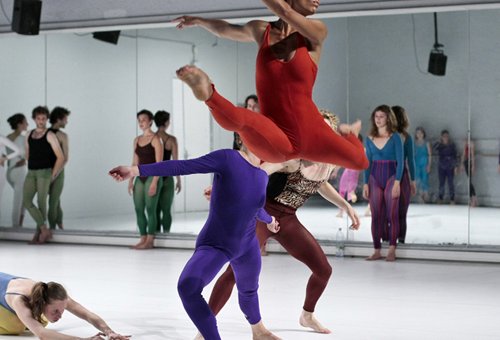
The performance exists in various versions: 50 ans de danse, performed by former dancers of the Merce Cunningham Dance Company, and Roman Photo with non-dancers, students and amateurs.
"In Merce Cunningham, un demi-siècle de danse [1], all Cunningham is included: pictures from every piece, and Merce is portrayed from the age of five... when I read this book, it came to my mind that the collection of the pictures was not only about nearly all the projects that he did until now, but formed a choreography in itself close to Cunningham’s processes to create dance: dance happens in between the postures, between two positions, and I guess we could invent a piece from this score of pictures, performed from beginning to end. On the one hand it would be a purely "fake Cunningham" piece, but on the other hand, I think if we succeed that it could become a real one, a real Cunningham piece, a Meta-Cunningham event with a glimpse of his entire life and work... I consider this experience as an integral part of our research, of our specific interest for the issue of archive, history and scores, which could meet here its tumultuous dimension: the entire history of a life’s work become book, transformed in its turn into a performance elaborated by a handful of dancers."
Boris Charmatz
Choreographer Boris Charmatz’s project originates with a book: Merce Cunningham, Fifty Years — a photographic collection recounting the course of this monument of history of dance. Going over in fast reading some hundred and fifty of his pieces, the show re-visits the movements of the forerunner, with John Cage, of chance operations and combinationals within the choreographic field.
For Boris Charmatz – initiator of the school project "Bocal" and director of the Dancing Museum – the patrimony is in the first place a living material, propitious to diversions and savage reappropriations. He has taken hold of those photographs as a "readymade" choreography, arranging them like a giant flip book which questions the mechanisms of gesture reproduction.
Dance in kit, animated photocopy, unrestrained performance, Flip Book is an unclassifiable and all-purpose object, initiated with art students, taken over by former interpreters of Cunningham, dancers and amateurs. A true-false Cunningham, playful and boisterous.
Gilles Amalvi in the programm of Festival d’Automne, 2009/2010
Running time: 40 min
François Chaignaud or Ashley Chen or Foofwa d’Imobilité, Raphaëlle Delaunay or Asha Thomas, Christophe Ives or Laurent Pichaud, Marlène Monteiro-Freitas or Latifa Laäbissi or Olga Dukhovnaya, Olivia Grandville or Lénio Kaklea, Mani A. Mungai
Lights: Yves Godin
Sound: Pascal Quéneau
Production direction: Sandra Neuveut, Martina Hochmuth, Amélie-Anne Chapelain
Production: Musée de la danse / Centre chorégraphique national de Rennes et de Bretagne directed by Boris Charmatz, is supported by the French Ministry of Culture and Communication - the Direction régionale des Affaires Culturelles, the city of Rennes, the regional Council of Brittany and the General Council of lle-et-Vilaine.
The Institut français regularly contributes to the international touring of the Musée de la danse.
Thanks to: LiFE (St Nazaire), HÜZ (Berlin), Centre de développement chorégraphique (Toulouse)
Flip Book premiered in 2008 at Life Saint-Nazaire
Cover picture: © Pierre Ricci/Photolosa / Flip book, CDC de Toulouse
[1] David Vaughan, Ed. Plume (French version), 1997 (out of print). "Merce Cunningham, Fifty Years" Ed. Aperture (original edition).



